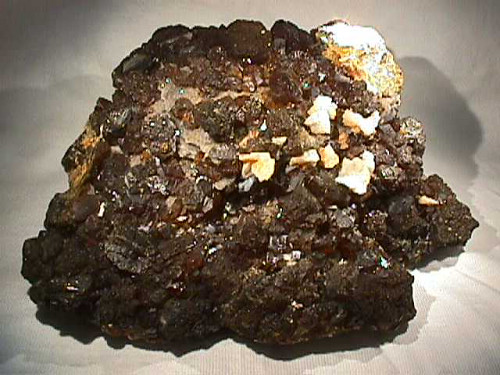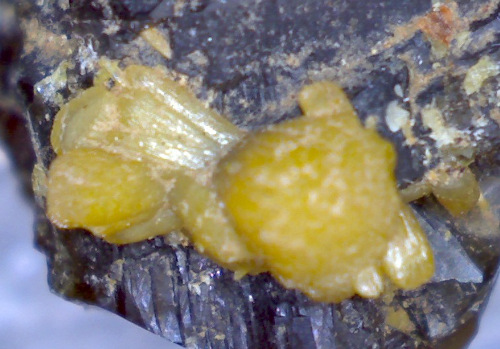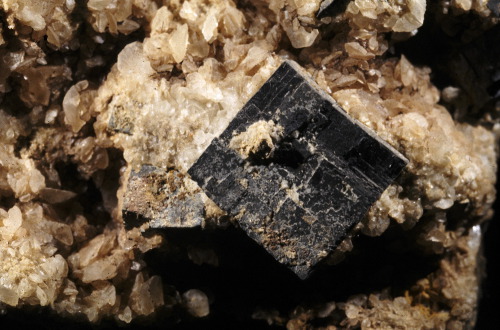Zinc and Lead
Zinc (Zn) is a bluish-white lustrous metal that is brittle at room temperature, but malleable when heated. It has a low melting point (419.5°C) and a moderately high specific gravity (7.13). Lead (Pb) is a soft, ductile, malleable, bluish-white metal with a low melting point (327.4°C) and a high specific gravity (11.3). Zinc and lead minerals often occur together because, as elements, they have similar chemical behavior and combine with sulfur as primary minerals.
.jpg)
Zinc (Zn)

Lead (Pb)
People have used zinc-bearing mineral compounds for more than 2,500 years. Only iron, aluminum, and copper are more used today. The main uses for metallic zinc are for galvanizing steel and iron, in making brass and other metal alloys, battery electrodes, sheet zinc, and as sacrificial metal to retard corrosion of ship hulls, pipelines, and other submerged or buried steelworks. Zinc compounds are ingredients in paints, rubber, chemical catalysts, fungus retardants, pharmaceuticals, electronic devices, and is the core of the U. S. penny.
Lead is easily recovered from its ore minerals. The mainl use of lead is in batteries. Lead oxides are added to glass, paint, ceramics, and other chemicals to impart special properties. Lead is alloyed with antimony, copper, and bismuth to make type metal. Compounds of lead, such as carbonate and acetate, are used in drugs.
The zinc minerals of commercial importance in Arkansas are sphalerite ((Zn,Fe)S) and smithsonite (ZnCO3). Sphalerite, contains 67.1 percent zinc, whereas smithsonite contains only 48 percent zinc. Sphalerite may contain small percentages of iron, manganese, or cadmium. Sphalerite is usually a shade of amber, has a resinous luster, and is transparent to translucent. Smithsonite is harder than sphalerite, has a glossy to pearly luster, usually is white to light brown, and is normally translucent. Some smithsonite with a striking yellow color and botryoidal habit is called "turkey fat" ore. Minor amounts of hemimorphite (Zn4Si2O7 (OH)2.H2O), were also mined in the north Arkansas zinc districts.

Sphalerite

Smithsonite bowtie on Sphalerite
Galena (PbS) is the only lead mineral of commercial importance in Arkansas. Galena contains about 86 percent lead, is very heavy (density of 7.4-7.6), gray in color with a metallic luster, and is easily cleaved. Silver may be an impurity, and if appreciable, it can be a by-product. Galena frequently forms with sphalerite.

Galena

Galena cube with calcite
Zinc and lead ores are present in the north Arkansas district, which includes Boone, Marion, Newton, Searcy, and parts of Baxter, Stone, Independence, Sharp, and Lawrence Counties, and the mineral belt of west-central Arkansas extending through and including all or parts of Pulaski, Saline, Garland, Hot Spring, Montgomery, Polk, Howard, Pike, and Sevier Counties. The north Arkansas district has been the most important commercially with more than 350 mines and prospects. The zinc and lead minerals in north Arkansas are present in irregular bodies in limestone, dolostone, and/or chert beds of Paleozoic age, often associated with local structural incongruities. Deposits have been mined from the Cotter, Powell, and Everton Formations (Ordovician), and the Boone and Batesville Sandstone Formations (Mississippian). They were mined mostly by under-ground methods, although some high-grade pockets of carbonate ore were open-pit mined. In west-central Arkansas, the zinc and lead minerals are associated with quartz veins in folded Paleozoic sandstones, shales, and novaculite. The Stanley Shale, Jackfork Sandstone, and Arkansas Novaculite host lead- and zinc-bearing quartz veins. Essentially all lead and zinc mining in the Ouachita region was by underground methods.
Although zinc is more common, lead ore was recognized and developed first in the north Arkansas district because of its use for bullets. The presence of lead in this district was noted in 1818. Lead was mined locally before the Civil War, and 3 lead refining furnaces (smelters) were in operation during the Civil War at Lead Hill in Boone County. Afterwards, lead deposits were worked intermittently through 1959 when mining ceased. The history of lead mining closely parallels that of zinc.
The earliest attempts to work north Arkansas zinc deposits were made in 1857 at Calamine, Sharp County, when a zinc smelter was placed in operation. Zinc mining began in the counties farther west in 1899 and reached its peak during World War I. Since 1918, there has been only intermittent mining activity in the district, ending in 1962.
In west-central and central Arkansas, a few zinc and lead mines were worked. The Kellogg mine immediately north of North Little Rock in Pulaski County was operated sporadically from 1840 to 1940 and concentrates of lead, zinc, silver, and copper were shipped out of state to be refined. This mine is the deepest shaft mine in Arkansas, with an inclined shaft that followed an ore vein to a depth of 1,125 feet. At Petty, 6 miles west of Gillham, Sevier County, several small lead and zinc mines were operated by the Confederate States Government in the early 1860's. Between 1,000 and 1,500 tons were mined and 3 lead furnaces were in operation. In 1899, the same mines were reopened for several years. During the first two years, 1,140 tons of ore were removed. The district has been essentially inactive since the turn of the 20th century.
Approximately 27,000 short tons of zinc and lead concentrates were mined from north Arkansas and about 5,000 short tons from the west-central district. During the entire period of lead and zinc mining in Arkansas little ore was found by drilling. The mines began on surface outcroppings of the ores in both regions of the state. Calculations indicate that 110,000 short tons (zinc-lead ores) of potential shallow resources remain. Significant potential exists in north Arkansas for the discovery of deep (>1,500 feet) deposits of lead and zinc as the southern extension of the New Viburnum lead district in southern Missouri.
References
Branner, J. C., 1892, The zinc and lead region of north Arkansas: Arkansas Geological Survey Annual Report for 1891, v. V, 395 p.
Konig, R. H., and Stone, C. G., 1977, Geology of abandoned Kellogg lead-zinc-silver-copper mines, Pulaski County, Arkansas, in Stone, C. G., ed., Symposium on the geology of the Ouachita Mountains, v. 2: Arkansas Geological Commission Miscellaneous Publication 14, p. 5-18.
McKnight, E. T., 1935, Zinc and lead deposits of northern Arkansas: U. S. Geological Survey Bulletin 853, 311 p.
Miser, H. D., and Purdue, A. H., 1929, Geology of the DeQueen and Caddo Gap quadrangles, Arkansas: U. S. Geological Survey Bulletin 808, 195 p.
Image courtesy of Stas1995 from https://commons.wikimedia.org/wiki/File:Zinc_(30_Zn).jpg
Image courtesy of Stas1995 from https://commons.wikimedia.org/wiki/File:A_piece_of_lead.jpg